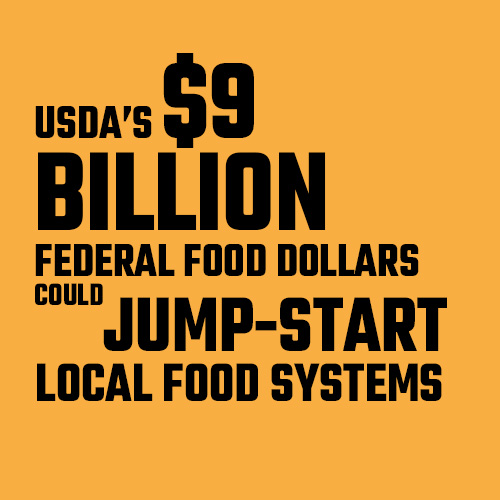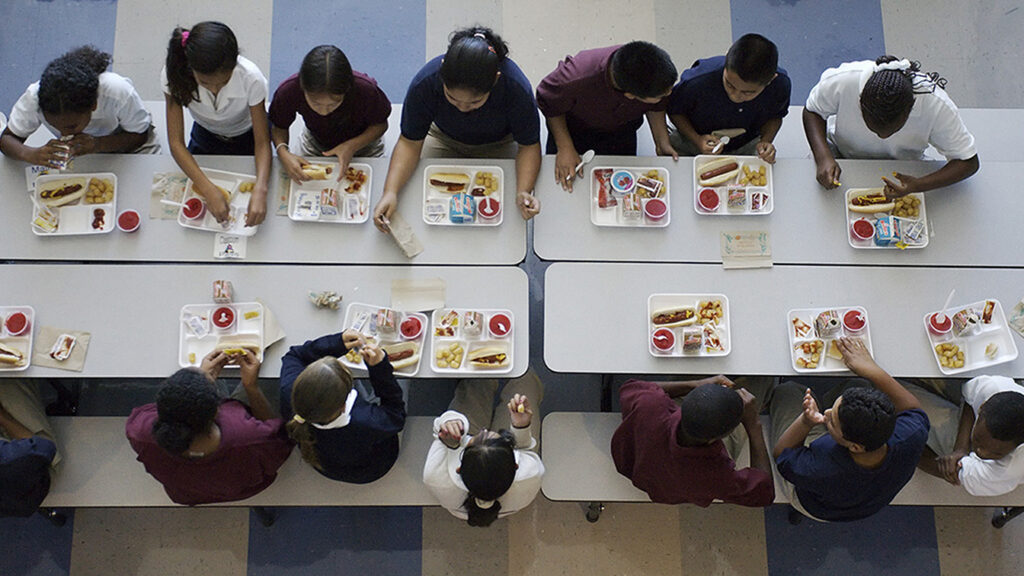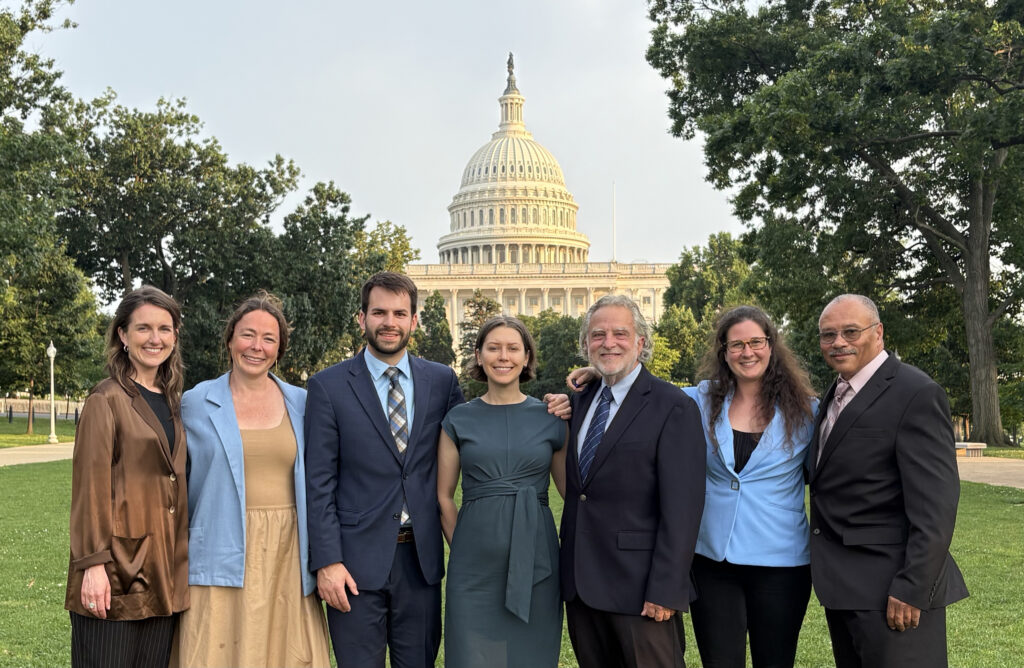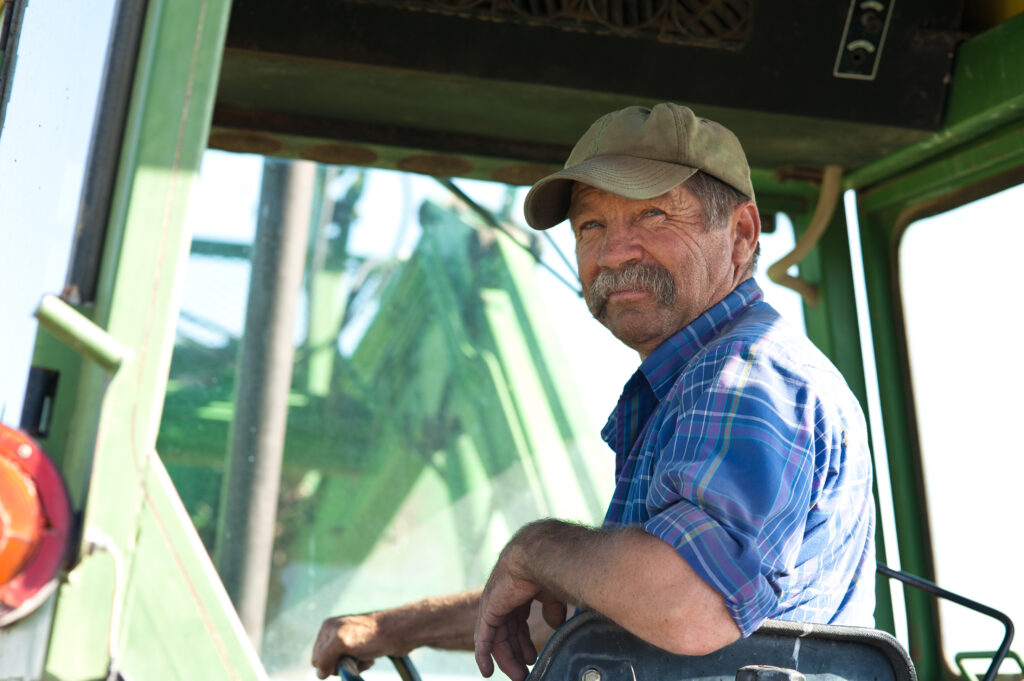Introduction
Every year, the U.S. government spends billions of dollars on food. In 2022, including everything from food for military bases to school lunch programs, the government spent more than $9 billion on food procurement.
The U.S. Department of Agriculture (USDA) and the Department of Defense get the biggest slices of the procurement pie; their authority to spend billions of taxpayer dollars translates into a great deal of power to shape our food system.
USDA’s Agricultural Marketing Service and its Commodity Procurement Program buy more than $3 billion dollars’ worth of meat, poultry, produce, dairy, and grains every year.
If these contracts went to family farmers and ranchers, the government could jump-start the regrowth of the local and regional food systems that were decimated by decades of industry consolidation.
Instead, the government has been directing taxpayer money into the pockets of the world’s largest and most abusive food corporations, reinforcing their domination.

Who Does the Government Buy Food from?
USDA provides a window into our government’s current procurement habits — and how they could be improved. Even a casual scroll through these vendor lists will tell you that the USDA routinely gives contracts in the mega-millions to Cargill, Tyson, and Smithfield.
An analysis of the government’s food procurement in 2022 revealed just how much more taxpayer money these consolidated agribusinesses get than anyone else: In every spending category, the majority of contracts were awarded to a small handful of corporations, instead of being distributed among many producers.
Just 25 vendors received nearly half of all food procurement dollars in 2022. That’s just 8% of the total number of vendors.
The greatest share went to Cargill (also known as the “Worst Company in the World”), which raked in 6% of all available contracts and almost 30% of the contracts for grain. Just five vendors claimed 81% of all poultry contracts, and half went to Tyson alone.
Despite notoriously unsafe working conditions, product violations, and bribery convictions on the part of its parent company, JBS snagged more than 60 million dollars in USDA Foods contracts.
What Happens When the Government Supports Monopolies with Taxpayer Money?
USDA Secretary Tom Vilsack defended the government’s apparent preference for buying from global behemoths like JBS: In a January 2023 letter, he said there is so little competition left in our food system that refusing to contract with the world’s largest meatpacking company would hurt taxpayers.
But giving taxpayer dollars to monopolies only entrenches their dominance and compounds our competition problem. We’ve seen this situation play out before — and spoiler alert, it didn’t work out for the taxpayer then, either.
Back in 2019, the USDA launched a Trade Mitigation Program to help U.S. farmers and ranchers hurt by the U.S. trade disputes with China. JBS got 26% of the allocation for pork purchases: $78 million in taxpayer dollars.
JBS won this contract, partly because as a multinational corporation it could offer rock-bottom prices, but also because USDA did nothing to let independent producers in on the process. On top of that, USDA failed to factor in the greater harm inflicted on the food system when choosing JBS for the contract.
A year later, JBS secured a deal to sell $700 million dollars’ worth of beef, pork, and poultry to China every year. This means that JBS used taxpayer dollars — meant to help U.S. farmers weather the trade war — to expand into China and take the market for themselves. The worst part of it is that JBS’s growth and global conquests do nothing for American eaters or the resilience of our food system.

What about USDA's Investments to Promote Competition?
President Biden’s executive order on competition directed the USDA to improve competition in the food system using a few different tools. So far, the Department has made some progress toward rebuilding the local and regional processing and distribution networks we’d need to keep more farmers and ranchers in business — but these investments are doomed to fail in the absence of policies that prioritize fair competition.
It’s already happened, in fact: After receiving more than a million dollars in state and federal grants and loans, a beef packing plant in North Dakota abruptly closed its doors. Doubtless faced with meatpacking and retail industries so consolidated he couldn’t get a foot in the market, the owner said, “I couldn’t figure out how to move beef more profitably.” It is highly likely that the new plants funded by USDA will eventually be bought out by the dominant meatpackers — or mega-retailers like Walmart, which happened in the case of Sustainable Beef — ultimately gifting those giant corporations with even more taxpayer dollars.
The USDA’s investments into independent businesses simply aren’t enough to get more players into the field, and that’s because after decades of consolidation across every sector of our food and farm economy, there are now only a few buyers in each region.
Where once farmers sold their goods to local independent grocery stores, those stores have been gobbled up by large, consolidated chains. Today the U.S. has one-third fewer grocery stores than it did 25 years ago, and 75% of U.S. consumers purchase their groceries from Walmart instead of locally owned grocers.
These buyers only want to work with producers as big as they are — rather than buying from dozens of smaller and independent producers. Even retailers like Wegmans, which has a reputation for offering more locally sourced and high-quality products, has told farmers in our network it was consolidating its local procurement to work with fewer (but larger) farms.
This means that farmers and ranchers have few local or regional options when it comes to selling their products. And without access to markets, family farms cannot survive.
How Could Changing Government Procurement Practices Improve Our Food System?
Remember those billions of dollars that the government spends on food every year? They could be leveraged to build a better food system for farmers and eaters alike.
By prioritizing independent farmers and ranchers in its food procurement policies, the government could:
- Sustain more independent businesses that grow and raise food for Americans.
- Revitalize rural communities.
- Keep control over the food system in the hands of farmers, local businesses, workers, and eaters.

USDA is already funding state-level programs that put this principle into practice. For example, the Regional Food System Partnership program deployed $4 million across eight states and in Washington, D.C. to help institutions purchase foods locally and from independent producers, guided by what’s called “values-aligned” procurement policy.
This demonstrates that the USDA understands the power of procurement policies that prioritize family farms, local resilience, and fair markets where independent businesses can thrive instead of the cheapest possible prices. Now it needs to walk the walk and implement these changes at the federal level.
There are signs the USDA is beginning to pivot. In November of 2023, USDA updated its domestic origin requirements so that any meat purchased in this category for nutrition assistance programs must be from livestock born, raised, and slaughtered in the U.S. The Department was already prioritizing food products of domestic origin for everything but meat; now, meat will be part of the imperative to buy U.S. products first.
This is a big deal for our cattle producers. In 2022, the U.S. government spent $1.9 billion on beef. According to the rancher advocacy group R-CALF USA, 2 million head of cattle were imported from Mexico and Canada that year. Under USDA’s new directive for the Agricultural Marketing Service to buy that cattle from U.S. ranchers instead represents a huge opportunity and will help ranchers stay in business by increasing demand for U.S. cattle. Applying this standard to the other major government food buyer — the Department of Defense — would direct all $1.9 billion in federal beef procurement dollars to producers of U.S. cattle.
Still, this is a drop in the bucket compared to the powerful firehose USDA could unleash with its full procurement budget. With congressional action, USDA could expand and invest more in programs like the Patrick Leahy Farm To School Grant Program, which spends about 10 million a year in grants to assist schools to buy local.
The mandatory funding for the Gus Schumacher Nutrition Incentive Program could also be scaled up. Many of the investments made through GusNIP give local producers a reliable buyer while increasing access to fresh and healthy foods for vulnerable populations.
While GusNIP currently operates with a preference for local and regional procurement, Congress should strengthen the connection between farmers and GusNIP so that the program stimulates local food economies with its annual budget of more than $50 million.
Along with the Local Food Purchase Assistance Agreement Cooperative Program and the Local Foods for School Cooperative Agreement Program, these programs will open market pathways for producers while we rebuild our food distribution system.
Bryn Bird of Bird’s Haven Farm illustrates how GusNIP creates market opportunities for farmers.
Congress could also help USDA create “set asides” so that independent businesses have a fighting chance at getting those government contracts, and also overhaul USDA’s bidding system, which is set up to prioritize the lowest-cost bids. USDA actually issued an official report requesting the authority to “allow the use of ‘local’ and other value-based criteria as a specification in federal food procurement.”
How Could Changing Government Procurement Practices Make Our Country More Secure?
On its journey from seed to grocery shelf, most of our food passes through a very narrow pipeline that is almost entirely controlled by big food monopolies.
Big Ag has the power to decide who farms, what they farm, and what we all eat — and they have been more interested in raking in subsidies to churn out feed for their industrially raised livestock than in producing food for people. This has put us all in a precarious position, dependent on imports from other countries to get the nutritious food our citizens need.
But we have the power to change that.
By calling for better government food procurement policy, we can use our taxpayer dollars to keep more farmers and ranchers on their land while supporting local and regional businesses. We can change our policies to achieve a strong and resilient food system: one that produces nutritious, accessible, locally and regionally grown food for all Americans.
Written, edited, and researched by Dee Laninga, Sarah Carden, Angela Huffman, Christian Lovell, and Joe Maxwell; Concept by Angela Huffman and Joe Maxwell.




